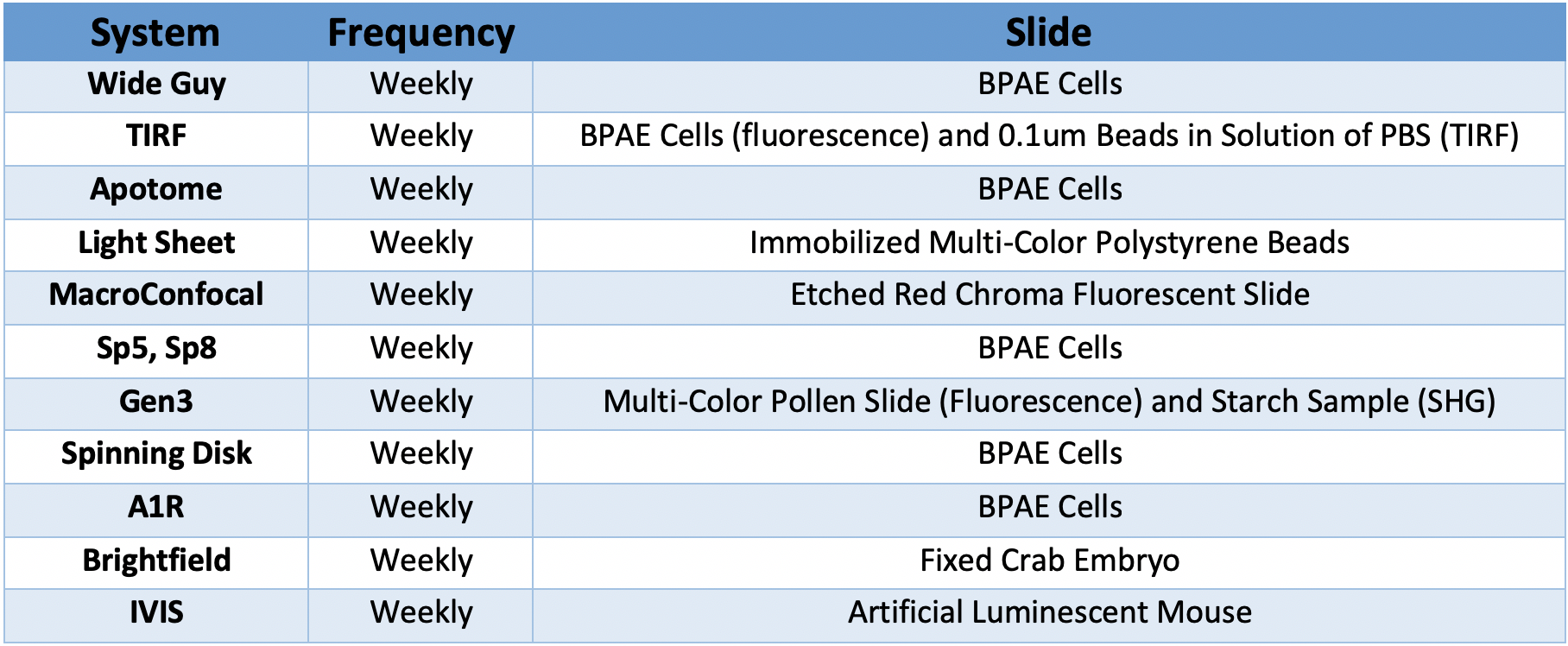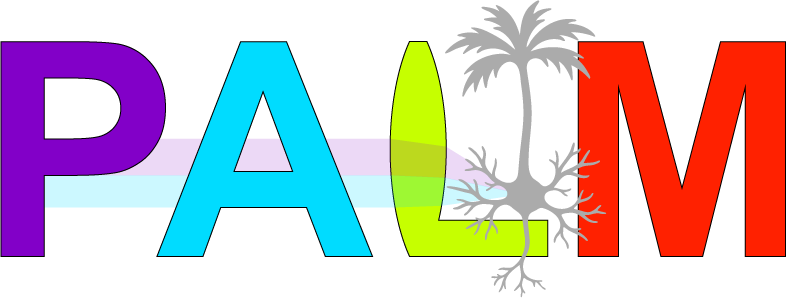BIDC Maintenance Schedule
The imaging systems at the BIDC undergo regular testing and maintenance in order to ensure that our community of users continually get publishable images of the highest quality. Our maintenance schedule has daily, weekly and quarterly components. At the BIDC, each staff member is assigned responsibility for a subset of the imaging systems. As such, this person will conduct the majority of maintenance and upkeep of their assigned systems.
Daily Testing
On a daily basis, a staff member of the BIDC makes a visual inspection of every system. An electronic checklist is maintained as record noting the condition of the microscope during this inspection. A simplified version of the checklist is presented in the table below. Any minor cleanings or replenishment of supplies is done during this time. If more extensive cleaning or potential repairs need to be carried out, the staff member responsible for that imaging system will be notified.

Table 1: Summary of Daily Inspections
Weekly Testing
On a weekly basis either during a training session or as an independent activity, each BIDC member collects images on their assigned microscopes of control slides and samples maintained at the BIDC. These include slides of fixed cells, pollen, starch and polystyrene beads. A record of these images is maintained noting the detector conditions, exposure time, objective, filters applied as well as color and power of excitation sources used in the experiments. These samples were selected to test the capabilities of each specific instrument. When images are compared in time, this practice gives us an immediate indication of problems with the primary components of the system, such as reduction in laser powers, degradation of resolution and failures of camera. The BIDC member will then carry out any required maintenance, alignment or repairs needed to insure proper functioning of the imaging system. Records of these test are stored for each instrument on our online server space referred to a Box at UCSF. Table 2 on the following page contains a summary of the samples used during these testing procedures.

Table 2: Samples for Weekly Testing
Quarterly Optical Testing
On a quarterly basis, all instruments undergo an in-depth regiment of optical testing. This testing determines if the objectives, detectors and excitation sources such as lamps or lasers are functioning properly. These tests are more in-depth than those done weekly and are used to check for problems that may not be apparent immediately to those collecting images. Records of these test are stored for each instrument on our online server space referred to a Box at UCSF. For each BIDC member, these tests should require a single day to complete.

Table 3: Summary of Quarterly Testing
Appendix with Descriptions of Quarterly Optical Testing
1. Optical Power
Optical power is how much energy a lamp or laser applies to a sample. Lamps and lasers can dim with time and with age, their output can fluctuate. Therefore, their performance needs to be recorded at regular intervals. Every quarter, we use an optical power meter to record the output our lasers and lamps. In this process, the light sensitive sensor on the power meter is placed directly under the objective lens and the power displayed on the meter’s gauge is recorded and logged. This is an absolute measurement of output. The power meter itself is sent every 5 years to ThorLabs for inspection and calibration.
2. Stability of Excitation Sources
In addition, the stability of each lamp and laser is also checked during the quarterly optical testing. For these tests, images are collected at intervals of one minute over an hour of our multi-colored calibration slides made by Chroma (blue, green, yellow and red). For a given excitation source, the fluorescence emission from these slides will not change in time. This test is performed for every color of excitation channel (color of exciting light) available on the instrument using a single objective lens. Following the tests, we conduct image analysis in MatLab where 5 regions of interest are collected (center and 4 corners). The average intensity is plotted in time for each region. If any change in mean signal over an hour is more than ten percent of the initial value or if any blurring of the image occurs during this time, a second test is conducted. If the lamp or laser continues to fail our testing, the company producing the unit will be contacted for further support and maintenance.
3. Point Spread Function
Experimentally, the point spread function (PSF) can be thought of as an image of any object below the resolution limit of the microscope’s objective lens. An image of a PSF is a direct indication of the resolving power of the objective. Therefore, any distortion in the image of the PSF is an early sign of damage to the objective that may not be apparent when imaging larger and more complex samples. As part of our quarterly testing, image stacks of a dilute samples of sub-resolution fluorescent polystyrene beads dried on coverglasses are measured on each of the microscope systems. These images are collected in both xy and z so that the 3D shape and extent of the PSF can be assessed. This procedure is carried out on our 20x, 40x, 63x and 100x objectives using beads with diameters from 0.1 to 2 microns. All imaging conditions included position of objective’s correction collars (if applicable), lasers used, filters applied and detector settings are recorded. It is recommended to use the FITC channel for this test.
Following image acquisitions, the stacks of images are inputted into a software called Imaris, which not only displays the full 3-dimensional volume of the PSF but also outputs the dimensions of the PSF. In the case of confocal microscopy, the PSF should resemble a nearly symmetric elliptical spheroid. However, when imaging with full-field microscopy, the PSF will also appear as a combination of the elliptical spheroid seen in confocal microscopy with definite fringes extending above and below the spheroid. The shape of the PSF, the symmetry of this shape and the dimensions of the PSF (width and height) are compared then to both previous measurements and theoretical estimates from literature. If any asymmetries, deviations in size or aberrations are noted in these parameters, the experiment is repeated. If cleaning of the objective, preparing of new sample or adjustment of the objective’s correction collar does not correct issue, the manufacturer will be contacted.
4. FlatField
A misaligned laser or lamp can cause the excitation field to be uneven. These problems can introduce differences in intensity in the acquired images that have no relevance to your sample. During the BIDC’s quarterly maintenance, we acquire images of our plastics fluorescent Chroma slides (blue, green, yellow, red) using the objectives and filters specific to each instrument. When cleaned, the fluorescence intensity emitted from these slides is uniform from a properly aligned instrument. During these tests, only the objective, excitation source and filters used needs to be recorded. Images collected during these tests are stored on the BIDC’s server referred to as Box. All objectives and filters on each instrument should be used for this test.
Analysis of these images is conducted using a program written in MatLab. The test begins by taking two sets of line scans through the image. When plotted, the intensities from these line scans must not deviate more than 10% from the value of the line scan in the middle of the image. The middle of the image is defined as the center of the image frame ± 10% in each direction (taken from each line scan). If an instrument fails this Flatfield test, the images and analysis must be repeated. For all instruments, BIDC members should check objectives for debris and visible abberrations. Issues with alignment of the excitation fields from the Sp5, Sp8 and Nikon A1R should be addressed by contacting the company. Alignment-specific directions for all other instruments are contained in the user manuals that correspond to those instruments.
5. Image Registration
At the BIDC, many users are interested in imaging samples with multiple fluorescent probes which absorb and emit light at different wavelengths. As a part of our quarterly testing, we test and verify that all optics and excitation sources are aligned so that these types of studies can be carried out accurately. At the BIDC, we prepared a slide containing polystyrene beads which have fluorescent probes attached to the exterior of the bead which absorb and emit fluorescence from the ultra-violet to the red areas of the electromagnetic spectrum. These beads are dried on a coverglass and imaged on all systems. The density of the beads is low such that beads do not overlap when imaged. Images of these beads should be collected with 20x, 40x, 63x and 100x objectives using beads of 2 to 5 microns. These beads should be greater than the resolution limit of the imaging system. All filters available on each instrument are used. Images of the center of the bead are collected as a single 2d image. In addition, full 3d image stacks of the beads are also be collected. All images are stored on the BIDC server along with the objective, filter and instrument which they correspond to.
The images of the center of the beads collected as a single 2d image are analyzed by a custom script in MatLab. In these images (all channels collected), the individual beads seen in the images are segmented. For a given bead, the images of this bead collected in all channels (i.e. DAPI, FITC, TRITC … ) are fit to an asymmetric 2d gaussian function. Therefore, for each bead, you will have a chi square value and a center (x,y coordinate) for each channel. With a chi square of less than two for each fit, the maximum distance between the centers for the bead in each channel, must be within less than 0.2 pixel. This test must be done for 5 beads for each objective on instrument. If test fails, please prepare a new slide and repeat test. If test fails again, please consult manual for directions on alignment tools for each instrument. Issues with alignment of the excitation fields from the Sp5, Sp8 and Nikon A1R should be addressed by contacting the company.
The 3d image stacks of the beads collected in each color are examined in Imaris. The image stacks collected for a given instrument should be inputted into Imaris as a 3d volume with multiple channels. Voxel-wise colocalization should be carried out using all channel combinations (i.e. DAPI-FITC, FITC-TRITC, TRITC-DAPI). Following background subtraction, more than 90% of the voxels in each channel combination should overlap for the test to be graded as successful. If test fails again, please consult manual for directions for alignment directions for each instrument. Issues with alignment of the excitation fields from the Sp5, Sp8 and Nikon A1R should be addressed by contacting the company.
